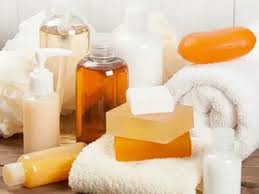Alkalis used in soap-making
1) Caustic soda, or sodium hydroxide or caustic soda, is the primary raw material for solid soap. Soap is first dissolved into a 30% solution and then used for boiling soap. It is saponified with oil to make soap, but the amount should not be too much, as excessive use can cause the soap to produce white frost
2) Soda ash, also known as sodium carbonate, is mainly used to saponify rosin. Adding 0.5-1% to soap fertilizer can increase soap’s hardness and washing ability, enhance its reflective ability, and prevent sourness. However, excessive use can cause soap to become crispy and produce white frost
3) Potassium hydroxide, also known as caustic soda, is a strong alkali that can only be used as an admixture of caustic soda when making soap. The amount used is about 5-10% of caustic soda, and excessive use can make the soap soft.
Other auxiliary materials include
1) Bubble alkali, also known as sodium silicate or water glass, is an important detergent and filler in laundry soap. The general dosage is 2-4%, which can increase the hardness of soap and reduce shrinkage deformation. At the same time, it acts as a buffer for residual free alkali, reducing irritation to human skin, softening hard water, reducing soap consumption, and preventing soap rancidity
2) Table salt, also known as sodium chloride, plays a role in salt precipitation during soap making, separating glycerol from the soap solution. It can reduce the moisture content of soap, improve its quality, lighten its color, and eliminate impurities
3) Rosin can increase foam and stabilize foam, increase solubility, prevent rancidity, refine soap tissue, reduce hoarfrost and lubricate skin, but excessive amount will make soap gradually discolor, and the washed clothes will turn yellow and have a sticky feel
4) Spices can counteract the sour and odorous taste of inferior oils. High grade soap uses vanilla oil, generally camphor oil, diphenyl ether, rosin alcohol, camphor oil, etc.
Below are several process formulas and production methods for making soap, for reference or selection
Formula 1: 70 parts butter, 25 parts coconut oil, 55 parts water, 25 parts sodium hydroxide solution with a concentration of 40 degrees, a little vanilla oil, 0.5 parts soap yellow (dissolved in an appropriate amount of alcohol). When making, the rosin should be melted in another pot and then mixed in a saponification pot; The saponification reaction can be carried out using the continuous saponification method. The soap yellow is added and stirred after the saponification reaction is completed, and then left to stand. Spices are added only when the temperature is slightly lower.

Formula 2: (Common formula for 53% fatty acid laundry soap)
1) 18 kilograms of coconut oil, 40 kilograms of vegetable oil, 12 kilograms of lard, 7 kilograms of cottonseed oil, 11 kilograms of decolorized rice bran oil, and 1.5 kilograms of table salt were dissolved in water to form a 35% solution and 0.24 kilograms of table salt were added. First, half of the solution was poured out, and 12 kilograms of rosin were crushed and slowly added to react fully. Then, the other half of the solution was added until no bubbles overflowed, making rosin soap liquid;
2) Dissolve 1.5 kilograms of 95% soda ash in water to form a 35% solution and add 0.24 kilograms of table salt. Pour out half of the solution first, crush 12 kilograms of rosin and slowly add it to react fully. Then add the other half of the solution until no bubbles overflow, making rosin soap solution;
3) Put a certain amount of 15% caustic soda solution into the pot, then add processed oil and heat it over high heat. When the material thickens and rises, reduce the heat or add an appropriate amount of cold water. When the saponification is close to completion and the reaction speed is slow, dip a wooden stick in the soap solution until it can form a hard piece. Otherwise, continue heating;
4) Add 20 kilograms of fine salt evenly to the soap solution, heat and stir. In the initial stage, heat vigorously and reduce the heat in the later stage. After flipping for 2 hours, leave the fire and let it stand for 3 hours to allow the soap to precipitate from the saltwater and float on top of the glycerol water. The lower layer of glycerol water is recycled and treated with sewage before being discharged. Add appropriate clean water to the soap and boil it into a uniform soap gel. Then, add saturated saltwater to further precipitate and remove the remaining glycerol and impurities. Repeat this process several times. To reduce the glycerol content in soap to below 2%, wash for 3 hours each time and let it stand for 3 hours. If high alkali content is found during salt precipitation and the waste liquid is unclear, some rosin can be added to the soap solution;

5) Add a certain amount of approximately 7% alkaline solution to soap and boil for 2 hours. After all the soap gel has separated, stop the alkaline precipitation. Let it stand for 3 hours and then drain the lower layer of alkaline precipitation water (alkaline precipitation can also be carried out twice or three times);
6) After alkali precipitation, the soap is left to stand for 3 hours and is divided into two layers: soap base and soap feet. The lower layer of soap feet is used again during alkali precipitation in the next pot. The upper layer of soap base is heated and boiled with appropriate water, and rosin soap solution is added to continue boiling for 2 hours. The initial heat is high, and the soap gel is stirred evenly before turning to low heat to prevent bottom scorching. Use a blade to place a few minutes in the soap solution and vertically extract it. When the soap gel adhered to the knife surface slides down, it forms a uniform thin sheet and the knife surface is smooth; it is a qualified soap. If the soap gel does not slide down too slowly, alkaline or saturated saline solution should be added. If it slides down too quickly, it is advisable to add some water appropriately;
7) Add 12kg of Paohua Alkali, a proper amount of whitening agent and essence, stir evenly, leave it for 4 hours, put it in an iron bucket to cool naturally, take out the cut pieces, dry them, and print them 10 days later to become the finished soap.
Formula 3: 50 parts vegetable oil, 14 parts coconut oil, 11 parts bran oil, 25 parts rosin, 8 parts 35% water glass, a little soap yellow, and 16 parts sodium hydroxide (mixed into a 30% solution).

Supplier
TRUNNANO is a supplier of sodium silicate with over 12 years experience in nano-building energy conservation and nanotechnology development. It accepts payment via Credit Card, T/T, West Union and Paypal. Trunnano will ship the goods to customers overseas through FedEx, DHL, by air, or by sea. If you are looking for high-quality sodium silicate, please feel free to contact us and send an inquiry.



